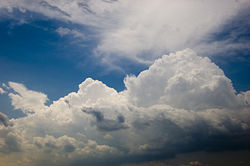Portal:Weather
2008/9 Schools Wikipedia Selection. Related subjects: Climate and the Weather; Portals
Weather is an all-encompassing term used to describe all of the many and varied phenomena that occur in the atmosphere of a planet at a given time. The term usually refers to the activity of these phenomena over short periods of hours or days, as opposed to the term climate, which refers to the average atmospheric conditions over longer periods of time. When used without qualification, "weather" is understood to be the weather of Earth.
Weather most often results from temperature differences from one place to another, caused by the Sun heating areas near the equator more than the poles, or by different areas of the Earth absorbing varying amounts of heat, due to differences in albedo, moisture, and cloud cover. Surface temperature differences in turn cause pressure differences. A hot surface heats the air above it and the air expands, lowering the air pressure. The resulting pressure gradient accelerates the air from high to low pressure, creating wind, and Earth's rotation causes curvature of the flow via the Coriolis effect. These simple systems can interact, producing more complex systems, and thus other weather phenomena.
The strong temperature contrast between polar and tropical air gives rise to the jet stream. Most weather phenomena in the mid-latitudes are caused by instabilities of the jet stream flow (see baroclinity) or by weather fronts. Weather systems in the tropics are caused by different processes, such as monsoons or organized thunderstorm systems.
Because the Earth's axis is tilted relative to its orbital plane, sunlight is incident at different angles at different times of the year. In June the Northern Hemisphere is tilted towards the sun, while in December it is tilted away, causing yearly changes in the weather known as seasons. In the mid-latitudes, winter weather often includes snow and sleet, while in both the mid-latitudes and most of the tropics, tropical cyclones form in the summer and autumn. Almost all weather phenomena can occur year-round on different parts of the planet, including snow, rain, lightning, and, more rarely, hail and tornadoes.
The eye of Hurricane Isabel approaches North Carolina's Outer Banks in this true-colour Moderate Resolution Imaging Spectroradiometer (MODIS) image captured by the Terra satellite on September 18, 2003 at 11:55 am US Eastern time.
Lightning strike near Swifts Creek, Texas dust storm, More...
...that the North Atlantic weather war was a true struggle in World War II, with both sides vying for superior weather data for a battlefield advantage?
...that one of only two F4 tornadoes to occur in the history of Florida touched down on April 15, 1958?
...that the United States receives more than 1200 tornadoes annually?
...that nearly 10 years before the 2008 Atlanta Tornado, the Dunwoody Tornado caused significant damage just outside the city limits?
...that the Lorain-Sandusky tornado was both the deadliest tornado and part of the deadliest tornado outbreak in Ohio history?
...that micrometeorology is a study of small-scale weather phenomena, which takes into account such small influences as heat transfer between the ground and air, changes in atmospheric gasses near the surface, and absorption and reflection of solar radiation?
John Park Finley ( 11 April 1854 – 24 November 1943 was an American meteorologist and Army Signal Service officer who was the first person to study tornadoes intensively. He wrote the first known scientific book on the subject of tornadoes, as well as many other manuals and booklets. He was responsible for the first national network for reporting tornado touchdowns and outbreaks, and kept an of tornado reports from across the United States. He also collected vast climatological data, setup a nationwide weather observer network, started one of the first private weather enterprises, and opened an early aviation weather school.



